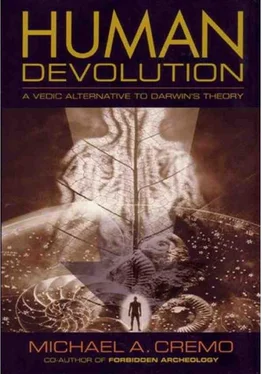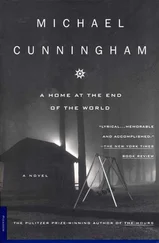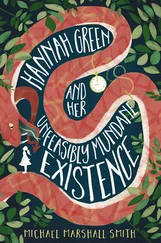Michael Cremo - Human Devolution - A Vedic Alternative To Darwin's Theory
Здесь есть возможность читать онлайн «Michael Cremo - Human Devolution - A Vedic Alternative To Darwin's Theory» весь текст электронной книги совершенно бесплатно (целиком полную версию без сокращений). В некоторых случаях можно слушать аудио, скачать через торрент в формате fb2 и присутствует краткое содержание. Год выпуска: 2003, ISBN: 2003, Издательство: Torchlight Publishing, Жанр: Старинная литература, на английском языке. Описание произведения, (предисловие) а так же отзывы посетителей доступны на портале библиотеки ЛибКат.
- Название:Human Devolution: A Vedic Alternative To Darwin's Theory
- Автор:
- Издательство:Torchlight Publishing
- Жанр:
- Год:2003
- ISBN:9780892133345
- Рейтинг книги:4 / 5. Голосов: 1
-
Избранное:Добавить в избранное
- Отзывы:
-
Ваша оценка:
- 80
- 1
- 2
- 3
- 4
- 5
Human Devolution: A Vedic Alternative To Darwin's Theory: краткое содержание, описание и аннотация
Предлагаем к чтению аннотацию, описание, краткое содержание или предисловие (зависит от того, что написал сам автор книги «Human Devolution: A Vedic Alternative To Darwin's Theory»). Если вы не нашли необходимую информацию о книге — напишите в комментариях, мы постараемся отыскать её.
Human Devolution: A Vedic Alternative To Darwin's Theory — читать онлайн бесплатно полную книгу (весь текст) целиком
Ниже представлен текст книги, разбитый по страницам. Система сохранения места последней прочитанной страницы, позволяет с удобством читать онлайн бесплатно книгу «Human Devolution: A Vedic Alternative To Darwin's Theory», без необходимости каждый раз заново искать на чём Вы остановились. Поставьте закладку, и сможете в любой момент перейти на страницу, на которой закончили чтение.
Интервал:
Закладка:
In the absence of a physical theory that determines the finely tuned fundamental constants observed in our universe, one can consider the possibility that some intelligent designer adjusted the constants. A good many cosmologists would rather not have it come down to this, so they appeal to the existence of innumerable other universes, in which the constants vary randomly. Among these universes is ours.
There are varieties of ways to get many universes. One proposal is that the Big Bang is cyclical. A Big Bang universe ends in a “Big Crunch,”compacting itself into a singularity, a point of unlimited density, and then bounces back into existence in another Big Bang. And the process repeats itself endlessly, with each universe having a different set of fundamental constants. But Barrow and Tipler (1996, pp. 248–249) stated: “Only in those cycles in which the ‘deal’ is right will observers evolve.
. . . The problem with this idea is that it is far from being testable. . . . Also, if the permutation at each singularity extends to the constants of Nature, why not to the space-time topology and curvature as well? And if this were the case, sooner or later the geometry would be exchanged for a noncompact structure bound to expand for all future time. No future singularity would ensue and the constants of Nature would remain forever invariant. . . . However, why should this final permutation of the constants and topology just happen to be the one which allows the evolution of observers!” For our purposes, the main point is that the cyclic universe idea is an untestable speculation motivated by the desire to avoid the idea that God finely tuned the fundamental constants and ratios we observe in our universe.
One of the main interpretations of quantum mechanics also assumes many universes. Quantum mechanics involves transforming the deterministic equations of ordinary physics to yield a wave function specifying a range of statistical probabilities. The situation we observe in the universe of our experience represents only one of these statistical probabilities. According to the “many worlds” interpretation of quantum mechanics, the other possibilities are simultaneously realized in separate universes.
Yet another way to introduce many universes is to propose that just after the initial Big Bang many regions of the universe had their own Mini Bangs and moved away from each other so quickly that light signals were no longer able to pass between them. Thus isolated from each other, these noncommunicating regions are in effect separate simultaneously existing universes.
No matter how they get many universes, cosmologists concerned with the fine tuning question go on to propose that in each of these universes the fundamental constants are adjusted differently, by chance. And we just happen to find ourselves in the universe where all these constants are adjusted so as to allow the presence of stable stars, planets, atoms, and the development of life forms.
Among modern cosmologists, Rees (2000, p. 4), for example, favors this many universe explanation. But he himself has admitted it is “speculative” (Rees 2000, p. 11). There is no way of demonstrating by the methods of modern materialistic science that these many alternative universes actually exist. And even if it could be shown they existed, one would have to further show that in each of them the fundamental constants varied randomly.According to theVedic cosmology,alternative material universes do exist. An unlimited number of them emanate from Maha Vishnu. But in each one of them there is life, according to the Vedic accounts, indicating that in each universe the fundamental constants of nature would show the appropriate fine tuning. In short, the hypothesis of many universes does not in itself provide an escape from the fine tuning problem or rule out providential design. In the absence of a physical theory that yields the observed values of the fundamental constants, and in the absence of experimental evidence for a multiplicity of universes with randomly varying fundamental constants, the fine tuning of physical constants that we observe in our own universe, the only one that we can observe, points directly to providential design. In essence, all the attempts by modern cosmologists to come up with alternative explanations are motivated by the desire to avoid the default conclusion that God is responsible for the fine tuning.
Human Devolution: a Vedic Account
Let us now review the path we have taken. The evidence documented in Forbidden Archeology shows that humans of our type have existed on this planet for the duration of the current day of Brahma, about two billion years. This archeological evidence, along with genetic evidence, contradicts current evolutionary accounts of human origins and opens the way to new kinds of explanations. We then decided that before we ask how humans came into existence, we should first of all ask the question, “What is a human being?” Today most scientists assume that humans are simply a combination of the ordinary chemical elements. We concluded, however, that it is more reasonable, on the basis of all available scientific evidence, to start with the assumption that humans are composed not just of one thing, ordinary matter, but of three things—ordinary matter, subtle matter in the form of mind, and consciousness. With this established, we found it natural for us to assume that the cosmos is divided into regions with different balances of these three substances. We also found it natural to suppose that in each region conscious beings exist, of different grades and powers, with bodies adapted to the conditions there. With these basic elements in place, it is now time to integrate them all into a comprehensive account of what I call human devolution, in a specifically Vedic form. To put the Vedic account in its most simple terms, we did not evolve up from matter; rather, we have devolved, or come down, from the level of pure spiritual consciousness.
Today, most people favor relatively simple accounts of human origins. They favor either a simple creation account, or a simple Darwinian evolutionary account, or a simple extraterrestrial intervention account. The Vedic account of human devolution involves elements of all three. In common with the usual creation account, the Vedic account posits the existence of an overall conscious designer and controller, God. But the Vedic account also incorporates something from the evolutionary account. By evolution, Darwinists mean reproduction with modification. As we shall see, the Vedic account also involves reproduction with modification, a kind of intelligently guided genetic engineering, which starts with the more complex and subtle life forms and then moves on to simpler and grosser life forms. The Vedic account also includes an extraterrestrial element. The Vedic tradition may support variants of the account I am about to give, but these variants all share a family resemblance with each other, and, more generally, with creation accounts from others of the world’s wisdom traditions.
The conscious self originally exists on the level of pure consciousness, in relationship with the supreme self, God, known in Sanskrit by many names, including the name Krishna, which means all attractive. The constitutional relationship of the particulate conscious self with the supreme conscious self is one of eternal reciprocal enjoyment. If a conscious self departs from its constitutional relationship with the supreme self, it descends to the level of the material energies. The basic motivation for this descent is the desire to assume the position of independent enjoyer, apart from the supreme conscious self. Because one cannot assume this position in the domain of pure consciousness, one must try to assume it in another domain, that of the material energies. The particulate conscious self then takes on a material body for action within the material energies.
Читать дальшеИнтервал:
Закладка:
Похожие книги на «Human Devolution: A Vedic Alternative To Darwin's Theory»
Представляем Вашему вниманию похожие книги на «Human Devolution: A Vedic Alternative To Darwin's Theory» списком для выбора. Мы отобрали схожую по названию и смыслу литературу в надежде предоставить читателям больше вариантов отыскать новые, интересные, ещё непрочитанные произведения.
Обсуждение, отзывы о книге «Human Devolution: A Vedic Alternative To Darwin's Theory» и просто собственные мнения читателей. Оставьте ваши комментарии, напишите, что Вы думаете о произведении, его смысле или главных героях. Укажите что конкретно понравилось, а что нет, и почему Вы так считаете.












